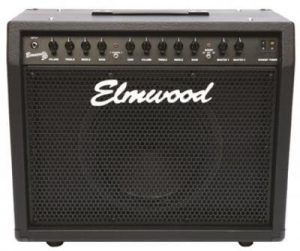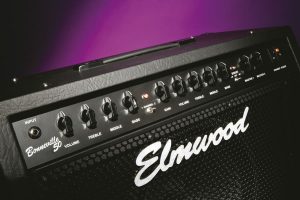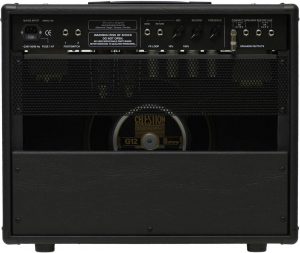Swedish valve outfit Elmwood made its name with the 60W and 90W Modena rock heads, but the Elmwood Bonneville 50 aims for max portability and any sound you want. Review: Huw Price
What’s the Swedish for ‘brick shithouse’? This amp is built like one. It’s a hell of a lump to carry about, and I’d be concerned about the solitary handle lasting the distance- but there are no such doubts about the plywood cab. The sides are about an inch thick and the Celestion G12 speaker is protected behind a stiff metal grille.

The cabinet has metal covers on all but the top front corners and the black vinyl covering is neatly done (you can also choose blue or red, and specify a gold speaker grille rather than black). Elmwood’s logo is blazed across the front in pearly white translucent plastic and the control panel is clearly laid out. It’s unlikely to win any style awards, especially when compared to similarly-priced US and UK competitors like Mango, Carr and 65, but it’s solid and serviceable.
Pros and Cons Elmwood Bonneville 50
Table of Contents
In fact ‘solid and serviceable’ are probably amongst Elmwood’s primary concerns and they’re renowned for their customer support. However, at this price it’s surprising that the valves and circuitry are PCB-mounted rather than point-to-point wired. The Elmwood Bonneville 50 is designed to produce the best tone that can be squeezed out of a quartet of ECC83s and a pair of EL34s while offering the ultimate in sonic versatility.
This is a two-channel amp, each with its own set of Treble, Middle and Bass knobs. Channel 1 is nominally the clean channel… up to 12 o’clock on the volume control. Beyond here the Volume behaves like a gain control, and a Master volume control sets the overall output level. You can swap to Channel 2 using the Channel switch on the foot controller or the toggle switch on the front panel. Ch2 is voiced hotter with a dedicated Gain knob to complement the otherwise identical control layout.

One reason the front panel is so uncluttered is that three of the controls are at the rear. A single Presence control shared by both channels, Reverb for the four-spring Accutronics reverb, and the Mix control for the FX loop. Mix is interesting. When fully counter-clockwise the loop is in parallel with the dry signal and only 10 per cent of the effect signal is mixed in, so the signal path is not affected.
Turning the Mix knob clockwise gradually puts the FX loop in series. At the full-on mark the FX loop is completely in series and the entire output signal from the preamp is routed through the effects chain before it reaches the power amp. The FX loop is designed for stompboxes, but it will operate with rackmounted units as well, and it’s active on both channels. Serial mode is recommended for ‘real time’ related effects like compression and equalisation, and parallel mode is preferred for ‘time related’ effects such as reverb and delay.
Features
Unusually the Bonneville 50 has two master volumes, Master 1 and Master 2. This allows you to make any sound you’re using louder at the flick of a footswitch. The procedure is to activate Master 1 and set it to the loudest level you’re likely to need for solos, then deselect Master 1 and set Master 2 to a lower level for your rhythm tone. The really clever bit is that if you find Master 1 is set too low or high, you can adjust it and Master 2 will automatically follow. So the volume ratio, or balance, between the two Master controls remains the same.
There are two switches labelled ‘Boost’ – one on the front panel and one on the foot controller – that activate a gain boost on both channels. When using the foot controller, the control panel toggle should be set to ‘Off’. The toggle also has an M1 setting where the boost is automatically activated when Master 1 is selected, so Master 1 mode can be set for higher gain than Master 2 – but you can still activate and deactivate Boost in Master 2 mode via the foot controller.

Sounds Elmwood Bonneville 50
Fifty watts of valve power through a Celestion G12 is a recipe for serious volume and consequently a sore head. The Bonneville 50 delivers on the volume front, but it doesn’t feel like it’s hurting your ears. The tone is thick and deep with no nasty high-frequency fizz.
The range of tones is bewildering, and the ‘clean’ channel is certainly no afterthought. Since the tone controls are so powerful it’s easy to dial in a throaty plexi Marshall clean tone. As well as snappy Fender-tinged country and funk. The quality of the reverb is exceptional, with a rich three-dimensional quality and no nasty popping or spitting.
Volume
The Bonneville eases into a throaty vintage-style overdrive when you push the channel volume and reign it back with Master 1 or 2. You can also get a slightly less compressed and brighter overdrive if you push the Master right up and roll back the channel volume. This channel is superb for sweet transparent jazz tone as well as raunchy blues Elmwood’s new Bonneville 50
The ‘drive’ channel has a far more contemporary edge but it’s just as versatile. Starting off from a rumbling dark overdrive. The Gain winds up to generate staggering levels of distortion. This really is a great amp for rock and dirty blues. With a maple-neck Strat it’s easy to get that singing latter-day Buddy Guy tone. And humbuckers will grind out ZZ Top and AC/DC tones all night.
At higher Gain levels the Bonneville 50 moves into the realms of modern metal and crunch. This is where the tone controls, especially Middle, really shine. They’re powerful enough to sculpt the tone without sounding artificial. Note separation is very impressive at high gain and the lows remain focused and tight.
There are so many different ways to use this amp that it would be impossible to cover them all here. The dual Master volumes work superbly for providing that extra lift, and there’s the Boost feature too; in a sense they do the same job, but Boost adds a brighter and grittier edge to the considerable sustain. In high gain mode it’s like switching from a JCM800 distortion to Dual Rectifier crunch.
Verdict
In my experience do-it-all amps often do everything adequately but only one or two things really well. If you’re lucky, and they can also be very complicated in use. But this Elmwood Bonneville 50 genuinely delivers the goods for crunch, distortion, overdrive and – most surprisingly – clean. It never sounds artificial or processed. All the tones are absolutely convincing and the cleverly thought-out footswitching arrangement makes things easy for the player. Our example did hum very slightly more than we might have expected. But the tone and dynamic response more than make up for it. This is an excellent amp for the gigging guitarist.

Leave a Reply
You must be logged in to post a comment.